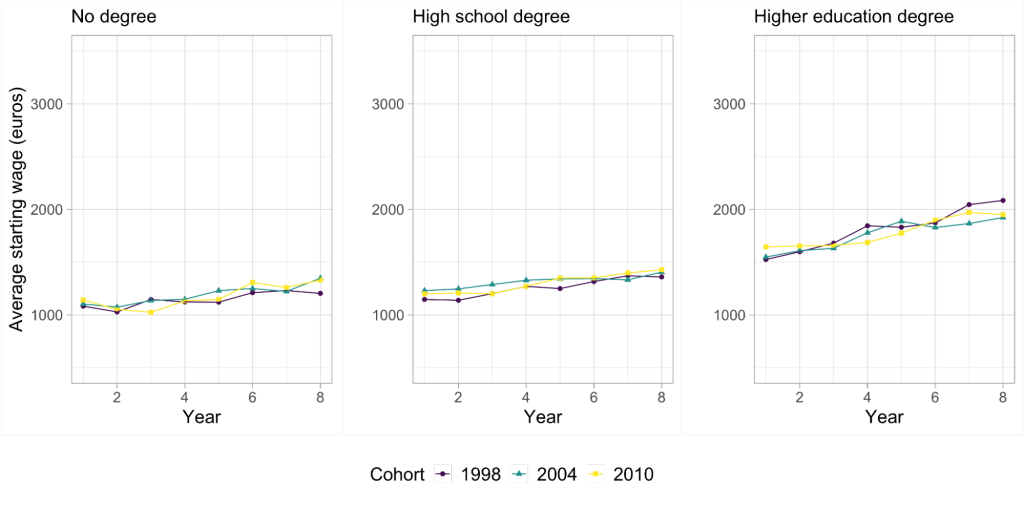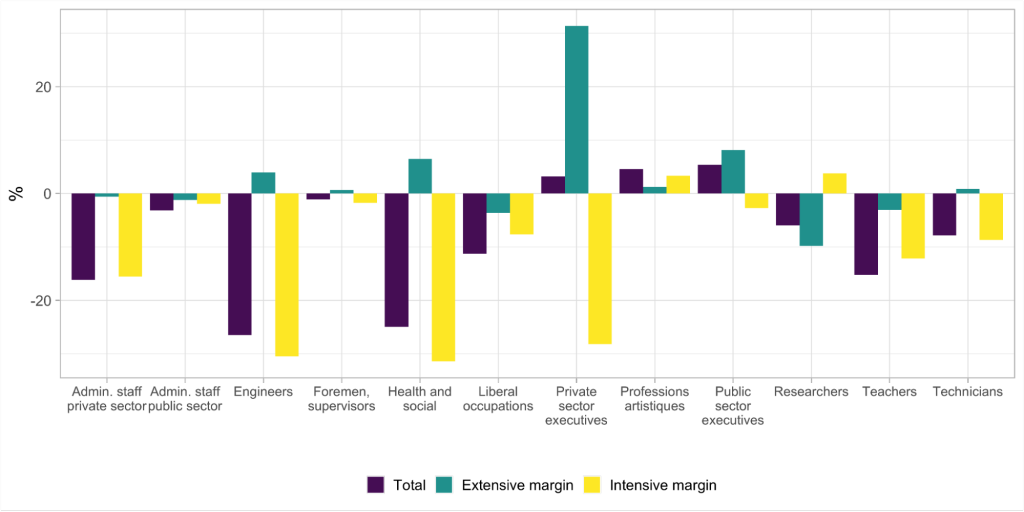


Directory of Researchers Analysing Labour
9 June 2022
Welfare and Reciprocity: Should We (Really) Feed the Surfers?
12 June 2022Every year in France, a new cohort of young people leaves the education system and enters the labour market. Available data show that wage growth over the first seven years of career slowed for those who entered the labour market in the early 2010s compared to those who entered in the late 1990s. In other words, the average annual wage increases were lower for recent cohorts than they were for older ones. Identifying the basis for these gaps provides basic information that would help anticipate labour market changes, design relevant public policies, and prevent future inequalities.
Identifying Affected Populations
The Generations surveys from the Center for Studies and Research on Qualifications (CEREQ) provides a complete overview of the career starts for young people who entered the labour market in 1998, 2004, and 2010. A study of these data reveals that the slowed salary increase is only apparent for higher education graduates. After controlling for the effects of gender composition, location, and sector of activity, the average salary(1)The average wage is calculated from the hiring salaries of contracts starting in the year, over the first seven years of each cohort’s career.. for this category of 1998 graduates increased 4% per year, compared to 3% for 2004 graduates, and slightly more than 2% for 2010 graduates. By comparison, the annual salary increase for high school graduates (baccalaureate or vocational certificate) was about 3% for both the 1998 and 2010 cohorts.
The figure below shows the wage evolution by education level for the three studied cohorts.
Figure 1: Average hiring salary by cohorts and level of education by the number of years since leaving the education system (CEREQ, Generations surveys)

What are the Roles of Supply and Demand in the Market for Recent Graduates?
The French labour market evolved between the 1990s and 2010, particularly with regard to the educational and age profile of individuals entering the market (supply). Similarly, the profiles sought by companies (the demand side)have changed over the period. On the supply side, the share of higher education graduates rose from nearly 24% of the working population to more than 36% between 1999 and 2011.(2)According to the INSEE surveys of 1999 and 2011.. In addition, the introduction of professional licenses and the standardisation of curricula ushered in by the Bologna process changed the profile of graduates.
On the demand side, economic theory predicts a series of potential effects of an increase in the share of graduates entering the labour market: the first effect posits that a degree signals the productivity of individuals. In this context, if the number of graduates increases, employers will consider (rightly or wrongly) that it is easier to obtain a degree, and therefore that the average productivity of graduates decreased. They will therefore offer lower wages. Second, given that the degree is a means of accumulating human capital, changes in the educational system and increases in the number of higher education students affect the nature and acquisition of this capital. Finally, if firms’ returns are falling, i.e. each new employee brings a lower productivity gain than the individual employed just before him/her, an increase in the number of hired graduates will automatically decrease their wages.
[Diagram Representing the Education-Employment Link]

To verify the validity of these hypotheses, it is possible to examine salary trends based on the nomenclature of 486 occupations and 31 socio-occupational categories (SOCs). Indeed, each position in a company has a given SOC, which provides information on the demand for the corresponding profile.
The evolution in the share of graduates working in each profession or category and the average salary progression within each of them also provides information on supply dynamics. Indeed, if the average wage progression decreases uniformly across all SOCs between the 1998 and 2010 cohorts, this would support the view that the degree is a signal and/or the hypothesis of the degradation of the degree as a means of human capital acquisition. On the other hand, if wage changes are related to the relative shares of the SOCs occupied by graduates, this would suggest instead that the productivity of graduates is related to firms’ diminishing productive marginal returns.
Breaking Down Salary Progression by Occupation
The difference in average salary progression between two cohorts can be broken down into an average of the differences in average salary progression by SOC, which can be weighted according to the relative weight of the SOCs. This results in an ‘extensive’ margin, which reflects the evolution of the share represented by this SOC relative to the other SOCs, and an ‘intensive’ margin, which is the average wage increase within the same SOC.If the extensive margin is positive, it means that a larger share of the most recent cohort is working in a SoC compared to the share represented by an older cohort.
If the intensive margin is positive, it means that the average wage in that SOC is increasing faster for the most recent cohort than for the oldest cohort. The analysis reveals that intensive margins are mostly negative. The figure below details the extensive and intensive margins of the main occupations and socio-occupational categories in which higher education graduates work (changes between the 1998 and 2010 cohorts).
Figure 2: Breakdown of salary progression by SOC – Higher education graduates (CEREQ, Generation Surveys)

This graph shows two things: first, the intensive margin is negative for almost all SOCs, i.e. salary progression has slowed down everywhere, except for teachers and researchers and for artists. Second, it varies bySOC: occupations where the intensive margin is most negative are engineers, private-sector executives, and medical and social professions. These three SOCs also share a positive extensive margin (i.e. a surplus of employees in 2010 compared to 1998). This last observation suggests diminishing returns to production by SOC, since it appears that the SOCs most affected by the slowdown in wage growth are among those with the largest inflow of new graduates. Business demand for higher education graduates appears to have held up, but has not increased sufficiently to compensate for the excess supply induced by the increase in the number of graduates.
The Dynamics of Salary Progression in Early Career
While the main cause of the slowdown in salary progression is an increase in the supply of graduates, the mechanisms yielding this result still need to be identified. We explore two of them: the first is access to managerial positions, and the second is the initial matching of degree majors and job occupation.
The share of new contracts involving managerial responsibilities is decreasing among higher education graduates: they represent a little over 23% of hires in the 1998 cohort, compared to a little over 20% of hires in the 2010 cohort. However, these contracts are accompanied by significant salary increases, particularly in the ‘higher’ SOCs where they are most represented. Seven to eight years after entering the job market, higher education graduates newly hired as managers earn about 18% more than employees who do not supervise a team if they work as an executive or in a higher intellectual profession, and nearly 17% more if they work in an intermediate profession. The 2010 cohort’s limited access to management positions is therefore a factor in low salary progression.
A second mechanism relates to degree majors and SOCs matching, i.e. their ability to combine. By ranking degree majors (mathematics, management, psychology, etc., offered by higher education degrees) according to the average salary that each brings within a SOC less than one year after graduation, we obtain a measure of the quality of the major-SOC matching. Young graduates are in a good match when the average salary obtained by their peers in the same major within the SOC in which they obtained their first job is high compared to other majors. Conversely, they are poorly matched if this average is below the other majors. The quality of the pairing is not fixed over time, and changes depending on the cohort considered.
This measure can be refined by calculating the difference between the average salary of the highest-paying major within the same SOC and the average salary attained through other majors. The evolution of this measure over time can be observed by calculating it for each cohort. The effect of the initial matching on the evolution of salary levels can also be studied.
Two findings emerge from these measures: first, matching quality deteriorates between the 1998 and 2010 cohorts, suggesting more inequality between majors within SOCs. For example, within the ‘Business executives’ SOC, the most poorly matched degree major for the 1998 cohort is Ex ‘Trade and management’, with an average wage gap of €137 with the best matched major (‘Humanities and law’). For the 2010 cohort, the least well-paired major within this same SOC is ‘Multi-skilled services’, with an average wage gap of €591 with the best-paired speciality (‘Services to People’, including health, teaching, and tourism).
Second, the impact of major quality on wages in subsequent years increased between the 1998 and 2010 cohorts. While its effect was only significant up to three years after the matching was measured for the 1998 cohort, it was significant up to seven years later for the 2010 cohort. Thus, an unfortunate early career matching had more lasting consequences for college graduates in 2010 than in 1998.
The two mechanisms explored – access to managerial positions and major/SOC matching– shed light on salary progression dynamics and suggest that oversupply of young college graduates in the labour market causes congestion. On the one hand, firms’ demand for managers falls, as these positions are already occupied, depriving the latest entrants of a means for salary progression. On the other hand, the consequences of the initial major-SOC matching persist for the last entrants, suggesting that they struggle to change SOCs if their initial matching was of low quality.
The excess supply of higher education graduates in relation to the demand from companies is therefore the main cause of the slower salary progression between 1998 and 2010. This phenomenon, which differs by occupation and socio-occupational categories, especially affects the ‘higher’ SOCs that grew most between 1998 and 2010. The excess supply resulted in more limited access to management positions and a higher weight for initial matchings in the medium term.
In the long term, a stalling salary progression beyond the first seven years of a career increases inequality between cohorts. It is not due to the quality of higher education degrees, but to the differential between supply and demand, and it may be difficult to correct with public policies targeting the supply side: only support for the demand side, i.e. ‘boosts’ to hiring and career advancement, could sustain the wage progression of the most highly educated.
Pauline Corblet, Department of Economics
Pauline Corblet is a doctoral student in the Department of Economics. She conducts her thesis under the supervision of Alfred Galichon (New York University and Sciences Po Paris). His research interests are in labor economics, search and matching models, and structural econometrics.
Bibliography
- Dupray, A. and Moullet, S. (2010). Offre éducative, valorisation des diplômés et effets de composition : deux générations de sortants de l’université au tournant des années 2000. Revue d’économie politique.
- Epiphane, D., Mazari, Z., Olaria, M., and Sulzer, E. (2019). Des débuts de carrière plus chaotiques pour une génération plus diplômée, CEREQ.
- Gaini, M., Leduc, A., and Vicard, A. (2013). Peut-on parler de générations sacrifiées ? Entrer sur le marché du travail dans une période de mauvaise conjoncture économique, Économie et Statistique.
- Kwon, I., Milgrom, E. M., and Hwang, S. (2010). Cohort Effects in Promotions and Wages: Evidence from Sweden and the United States, The Journal of Human Resources.
- Nauze-Fichet, E., Tomasini, M. (2002) Diplôme et Insertion sur le Marché du Travail : Approches socioprofessionnelles et Salariale du Déclassement, Économie et Statistique.
- Liu, K., Salvanes, K. G., and Sørensen, E. O. (2016). Good skills in bad times: Cyclical skill mismatch and the long-term effects of graduating in a recession, European Economic Review.




